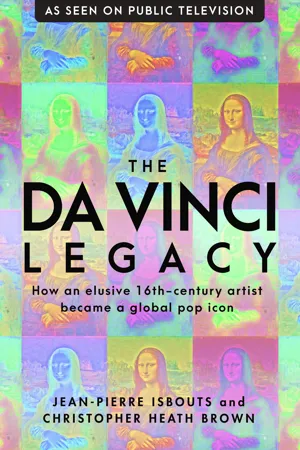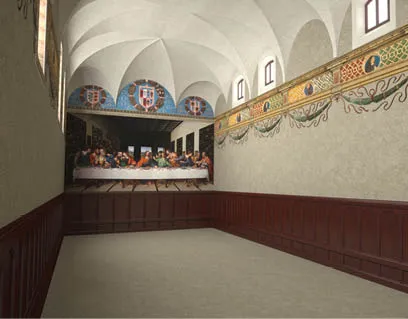![]()
![]()
![]()
HOW AN ELUSIVE 16TH-CENTURY ARTIST BECAME A GLOBAL POP ICON
JEAN-PIERRE ISBOUTS and CHRISTOPHER HEATH BROWN
![]()
The da Vinci Legacy: How an Elusive 16th-Century Artist Became a Global Pop Icon
Copyright © 2019 by Jean-Pierre Isbouts and Christopher Heath Brown
All rights reserved. No part of this book may be used or reproduced in any manner whatsoever without the written permission of the publisher, except in the case of brief excerpts in critical reviews or articles. All inquiries should be sent by email to Apollo Publishers at [email protected]. Apollo Publishers books may be purchased for educational, business, or sales promotional use. Special editions may be made available upon request. For details, contact Apollo Publishers at [email protected]. Visit our website at www.apollopublishers.com.
Library of Congress Cataloging-in-Publication Data is available on file.
Print ISBN: 978-1948062-34-3
Ebook ISBN: 978-1-948062-35-0
Printed in the United States of America.
Cover and interior design by Rain Saukas.
Cover image © make.
![]()
Introduction
1. Leonardo in Amboise
2. The Legacy of Leonardo’s Studio
3. The Leonardeschi after Leonardo
4. Leonardo and the Artists of the High Renaissance
5. Leonardo in the Literature of the 16th Century
6. The Leonardo Legend and the Art of Engraving
7. The and the in the Baroque Era
8. Leonardo’s Legacy in the 19th Century
9. Leonardo da Vinci in the 20th Century
10. The Legacy of Leonardo
Select Bibliography
Notes
Credits
Acknowledgments
![]()
A digital reconstruction of the Cenacolo (the Last Supper hall) in the former refectory of the Santa Maria delle Grazie as it appeared in the early 16th century
![]()
A hush fell over the crowd as one of the last lots of the evening was brought into the room. Those in the front rows—the top buyers, curators, and billionaire collectors—moved slightly forward in their seats, craning their necks to better see the portrait on the dais in front of them. Among their ranks were some of the most powerful dealers and collectors in the world, including New York’s Larry Gagosian; David Zwirner and Marc Payot of Hauser & Wirth; Eli Broad and Michael Ovitz from Los Angeles; and Martin Margulies from Miami. Those standing in the back of the room pushed and jostled in the hope of catching a glimpse of the painting, a surprisingly small panel at just 26 by 19 inches. Outside, New York was enjoying one of the last balmy nights of the city’s famous Indian summer, but inside, the air conditioning systems were working overtime to cool the rising heat of the packed room.
Jussi Pylkkänen, the global president of Christie’s, seemed unfazed as he looked at the more than one thousand dealers, advisors, journalists, and critics who had somehow secured tickets to get inside his auction hall at Rockefeller Center. He cleared his throat, brushed some dust from the lectern in front of him, and said, “And so, ladies and gentlemen, we move on to Leonardo da Vinci, his masterpiece of Christ the Savior, previously in the collection of three kings of England.” Inwardly, however, Pylkkänen could barely contain his excitement.
The reason is simple: works by da Vinci are rare. So rare, in fact, that any time a bona fide work by this elusive Italian artist makes it to an auction floor, it automatically generates headlines all over the world. Unlike, say, Vincent van Gogh, who could turn out one or more paintings in a day, Leonardo labored over his paintings for months, even years. The reason, his 16th-century biographer Giorgio Vasari claimed, is that “the work of his hands could rarely match the perfection of his imagination.” But that judgment tells only half the story. The fact of the matter is, Leonardo saw himself as much more than a mere painter. He was fascinated by science, nature, human biology, and great mysteries such as the flight of birds or the movement of water. He burned with ambition to become a famous architect like his friend Donato Bramante, or an engineer like his fellow Florentine Filippo Brunelleschi, who had secured his fame by creating a vast dome over the central crossing of Florence’s cathedral. At the same time, Leonardo was fascinated by optics and the way our eyes perceive the effect of atmosphere and depth; he spent hours investigating the play of light and shadow on the face of a beautiful young woman. Yes, Leonardo believed he was much more than a painter—a character who, in the quattrocento, the 15th century, was still considered little more than an artisan with a dirty smock. If he were alive today, he would be called a true Renaissance man, even though, ironically, that term had yet to be invented when Leonardo was alive.
As a result, there are only some eighteen paintings that we can reliably accept as true da Vinci “autograph” works today. That is an amazingly small number, especially when you consider that Leonardo’s contemporary, Sandro Botticelli, completed well over a hundred paintings during the same time period. And these are just the Botticellis that we know of, since the artist burned a goodly number of his mythological paintings after he heard the sermons of a fiery monk named Savonarola. Worse, two of Leonardo’s most famous frescoes, the Last Supper in Milan and the Battle of Anghiari in Florence, are no longer visible in their erstwhile glory: the former because the mural is hopelessly damaged, and the latter because it was overpainted in the latter part of the 16th century. Only a handful of copies give us an inkling of the immense visual power that these works brought to the Renaissance.
For Leonardo, this was especially unfortunate because frescoes—which cannot be bought or sold, and always remain in place—were the principal medium in which an artist could secure his reputation for all time. Leonardo’s chief rivals, Raphael and Michelangelo, had sealed their celebrity with a series of highly suc...





